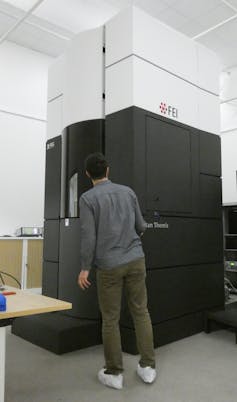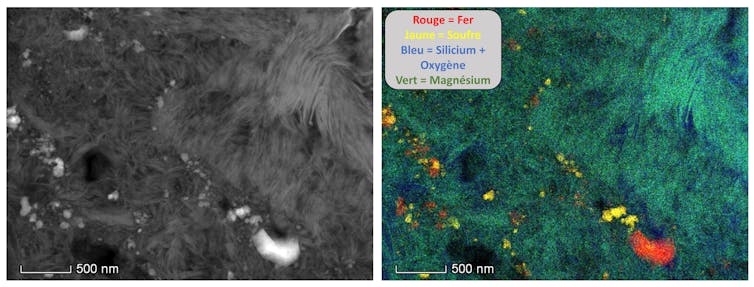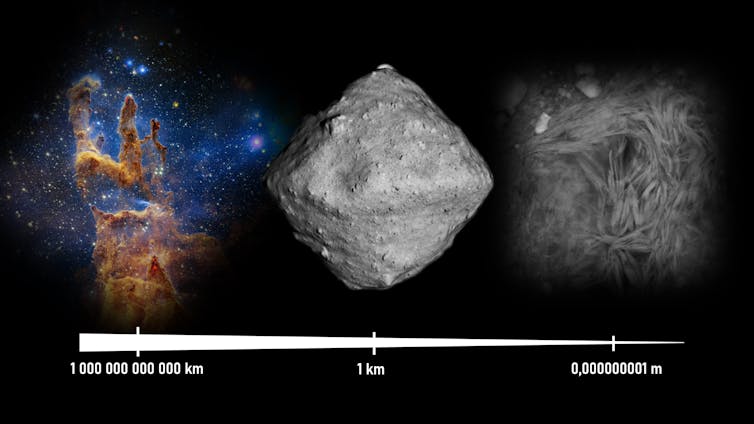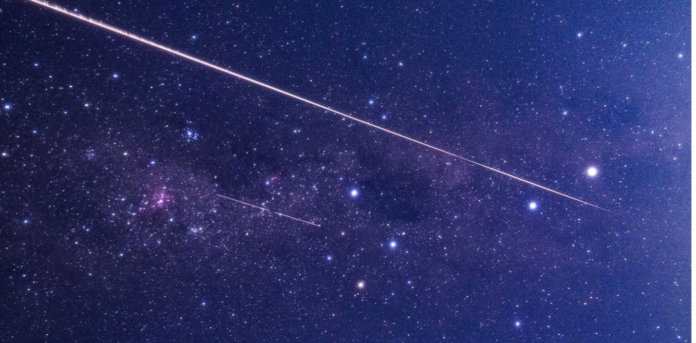The Habayusa2 mission brought dust from the asteroid Ryugu back to Earth in 2020. These few grams of samples, shared between scientific teams around the world, give clues to the origin of water on our blue planet .
Among the planets in the solar system, Earth is the only one to have large bodies of liquid water on its surface. Accounting for nearly 70% of its surface, the oceans have enabled the emergence and development of living things. But where can all this water come from? And what were the processes of formation of the oceans?
Around 4.57 billion years ago, the Solar System was born from a cloud of gas and dust rotating around the young Sun. Over time, under the effect of gravity and multiple collisions, this matter gradually coalesced to form planets… including Earth.
Several scenarios, which are not antagonistic but complementary, are put forward to explain the origin of water on what will later become the blue planet. One of them suggests that water would be present within the very material present in the protoplanetary disk which accreted to form our planet. In this case the water could have been trapped in the form of small fluid inclusions in the minerals, or present within the structure of these minerals, relatively uniformly diluted.
Another hypothesis states that the supply of water to the Earth would have been later, through the falls of comets or asteroids rich in water. Due to their relatively small size, compared to planets, asteroids have not experienced high temperature events that could have modified their chemistry. As a result, they have evolved very little since their formation 4.57 billion years ago.
Asteroids, markers of the genesis of the solar system
While terrestrial planets formed close to the Sun (between 0.4 and 1.5 astronomical units, one astronomical unit represents the distance from Earth to the Sun, approximately 150 billion kilometers), asteroids are mainly present in regions more distant from the Sun, particularly in the “main belt” (2 to 4.5 astronomical units).
These colder regions are conducive to the agglomeration of water ice and silicate dust, which gives rise to asteroids. After their formation, certain asteroids migrate within the solar system, to reach orbits closer to the sunsimilar to that of the Earth: these are the near-Earth asteroids. Among them, the carbonaceous asteroid Ryugu (1 kilometer in diameter), was the object of study of the space mission Hayabusa2 conducted by the Japanese Space Agency (JAXA) between 2014 and 2020.
JAXA, CC BY

JAXA, Provided by the author
The probe first studied Ryugu closely, then collected samples in an impressive maneuver, before returning to Earth. Thus, on December 6, 2020, a few grams of dust (5.4 grams) from this asteroid landed in Australia aboard a capsule, and it was with joy that we received at the University of Lille a very small part of this treasure: a few grains, barely visible to the naked eye, perhaps holding elements of answers allowing us to understand the formation of the oceans on Earth.
Observations at the nanometer scale using an electron microscope

Authors, Provided by the author
Our research work consists of deciphering this celestial matter, down to the atomic scale, in search of the slightest clue! The instrument we use to probe this scale is a transmission electron microscope. It emits a beam of electrons which passes through the sample. The signal collected, following the interaction between this material and the electron beam, provides us with structural and chemical information on the mineralogical assemblages that constitute it. This technique makes it possible to observe details down to a nanometer, or a billionth of a meter, which is equivalent to dividing the thickness of a hair by 100,000.
The “hidden” water of Ryugu
Studies of samples from the asteroid Ryugu reveal that they are relatively dry, that is, they contain very little molecular water H20. On the other hand, these samples are mainly made up of clays rich in magnesium and iron: they represent more than 70% of the asteroid’s volume. These clays are minerals with a microscopic structure consisting of a stack of layers (which can potentially accommodate water molecules), thus called “phyllosilicates”. They contain abundant hydroxyl groups (-OH) which are intrinsically building blocks of their crystalline structure. The latter are made up of oxygen and hydrogen, that is to say the same atoms as those which constitute water molecules.

Authors, Provided by the author
One of the reasons for the presence of phyllosilicates in small asteroids dates back to the beginnings of the Solar System. During the formation of the latter, approximately 4.57 billion years ago, dust and ice gradually agglomerate until giving birth to planets, asteroids as well as other celestial objects (comets …). On small asteroids such as Ryugu, dust made of anhydrous silicates (devoid of water) coexists with water ices. Shortly after the formation of the asteroid, it will heat up following the spontaneous disintegration of radioactive elements, which melts this water ice. What follows is episode of “aqueous alteration”, where this water interacts with surrounding silicates to form the phyllosilicates we see today in Ryugu.
During the formation of the Earth, and shortly after its formation, the massive falls of asteroids similar to Ryugu may have delivered abundant quantities of phyllosilicates. Following high temperature events on Earth, hydroxyl groups (-OH) would have been detached from the mineralogical structure of clays to form water molecules:

The intense bombardments of asteroids such as Ryugu suffered by the Earth during its young years would thus have strongly participated in the progressive formation of the oceans.

NASA (JWST); JAXA; authors, Provided by the author
Water… but not only that!
The asteroid Ryugu is therefore made up of more than 70% phyllosilicates, but it also contains a few percent of organic matter (around 5 to 7% by mass).
This material, made up of carbon, hydrogen, oxygen and nitrogen, houses molecules essential to the development of life on Earth: amino acids. These short molecules are the building blocks involved in the structure of proteins. Although present in small proportions in Ryugu, this presence of amino acids suggests that carbonaceous asteroids were able to provide the necessary ingredients for development of life on Earth about 3.8 billion years ago.

This article is published as part of the Science Festival (which takes place from October 4 to 14, 2024), and of which The Conversation France is a partner. This new edition focuses on the theme “ocean of knowledge”. Find all the events in your region on the site Fetedelascience.fr.

